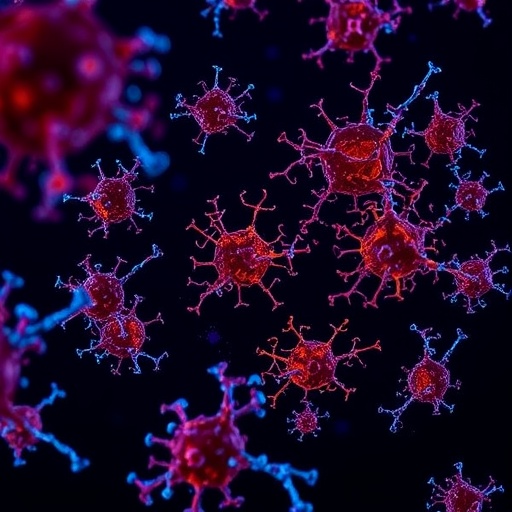A new type of molecule blocks the action of genes that drive the growth of therapy-resistant prostate cancer, a new study finds.
"Rather than continue making compounds that are just like older drugs, the focus of our work has been to rethink the definition of what a drug-like molecule can be," says corresponding author Susan Logan, PhD, associate professor in the Department of Urology, at NYU School of Medicine.
A joint research team from the School of Medicine and New York University found that their "cyclic peptoids" reduced the growth of prostate cancer cells in cultures by 95 percent compared to untreated cells. The experimental drugs also blocked a key, related growth signal in live animal tests.
"We designed our peptoids specifically to hit targets that are currently 'undruggable,'" such as those causing treatment-resistant prostate cancer," adds co-senior author Kent Kirshenbaum, PhD, professor in the Department of Chemistry at New York University.
According to the team's report, published online October 23 in Nature Communications, the study compounds blocked growth by interfering with the interaction between the protein beta catenin and T-Cell Factor (TCF) transcription factors — proteins that turn on genes that make cells multiply. Although the genes are critical for early development of prostate tissue, this gene activity is normally dialed down in adulthood, unless changes re-activate it, which can lead to cancer.
First Test
Unlike many existing drugs, the new compounds do not target androgen hormonal signals known to encourage prostate cancer. Most patients treated with anti-androgen drugs see their cancer growth resume within months, so the field has sought additional therapeutic strategies. Many efforts have focused on abnormal Wnt protein signals that occur in 20 percent of the most treatment-resistant prostate tumors, but none have made it to the clinic.
Wnts can cause the buildup of the protein β-catenin in cell nuclei, where it turns on genes. Leading up to the new study, the research team had spent years designing a new class of rugged, adjustable, protein-like compounds called peptoids that are just large enough to engage with the broad, flat surfaces used by beta catenin to interact with TCFs.
Further, the researchers knew their compound must be engineered, not just to include the right chemical components, but also to fold into a desired 3-D form. The researchers "stapled" together the ends of a linear peptoid molecule to form a loop-like, or cyclic, structure. This form resembled the protein hairpins that TCFs depend on to interact with beta catenin. The stapling stiffened the peptoid such that it could occupy and block the docking site that TCFs would otherwise use.
A new generation of computer simulation tools enabled the team to see early on how drug candidates might fit into their protein target. After this virtual testing, the team then synthesized the compounds for experiments in nutrient-filled, artificial environments called spheroids, where cancer cells grow in three dimensions (more lifelike than in 2D petri dish cultures).
In these experiments, cyclic peptoids reduced treatment-resistant prostate cancer cell growth by roughly 95 percent when compared to untreated cancer cells over 22 days, which compared to just 40 percent growth reduction in cells treated with the unstapled version of the peptoid. The compounds also decreased androgen hormonal signaling, suggesting a dual anti-cancer effect, say the authors.
The researchers also wanted to show that their lead compound could block beta catenin signals in a live animal. They chose zebrafish, in which rare genetic changes (mutations) that let beta catenin build up are known to keep eyes from forming. In repeated experiments in fish with such mutations, the team found that that their looping peptoids – by blocking over-active beta catenin:TCF interactions similar to those affecting human prostate cancer – rescued eye development.
Furthermore, the treatment showed no toxicity in zebrafish at the rough equivalent of a dose that may work clinically in humans. Moving forward, the team will soon test their peptoids on human prostate cancer cells grown in mice. In addition, tests are planned to see if the compound can block the β-catenin:TCF interactions known to encourage growth in colon and breast cancers.
###
Envisioning the design of a new drug class required a multi-disciplinary effort. Logan is an expert in prostate cancer, and helped to choose beta catenin as the cyclic peptoid target. Study author and androgen expert Michael Garabedian in the Department of Microbiology at NYU Langone Health has long collaborated with the team of chemists at NYU led by senior study author Kent Kirshenbaum which designed the peptoids.
First author Jeffrey Schneider was the MD/PhD student in Logan's lab who did much of the experimental work on the project; and co-first author, Tim Craven of the NYU Department of Chemistry, a student in Richard Bonneau's lab in NYU's Center for Genomics and Systems Biology; designed the active cyclic peptoid.
Holger Knaut of NYU Langone's Skirball Institute of Biomolecular Medicine led the zebrafish work. Other study authors included Dr. Amanda Kasper and Michael Haugbro in the NYU Department of Chemistry, Chi Yun, also of the Skirball Institute; and Erica Briggs in the Department of Urology at NYU School of Medicine.
This work was supported by NIH grants CA112226, T32GM007308, 5T32CA009161, and NS069839, and by National Science Foundation grant CHE-1507964. Further support came from the New York University Biology Department's Fleur Strand Fellowship and the Graduate School of Arts and Science-funded Horizon Fellowship in the Natural and Physical Sciences.
Media Contact
Greg Williams
[email protected]
212-404-3500
@nyulangone
http://nyulangone.org/




